Interrelationship Between Vulnerability & Social and Health Problems
VerifiedAdded on 2023/06/10
|12
|1590
|219
Presentation
AI Summary
This presentation delves into the intricate interrelationship between vulnerability and various social and health problems, including homelessness, poverty, mental illness, rural and migrant health, infectious diseases, addiction, and violence. It defines vulnerability in the context of health and social care, highlighting the key determinants that contribute to the susceptibility of populations to poor health outcomes. The presentation analyzes how each identified vulnerability, such as poverty leading to neglected health and homelessness resulting in exposure to diseases, exacerbates social and health issues. It further explores the interconnectedness of these vulnerabilities, demonstrating how one can trigger or worsen others, creating a cycle of disadvantage. The presentation concludes by emphasizing the need for appropriate health and social care initiatives to address these vulnerabilities and restore well-being, referencing sources like the World Health Organization and Healthy People 2020.
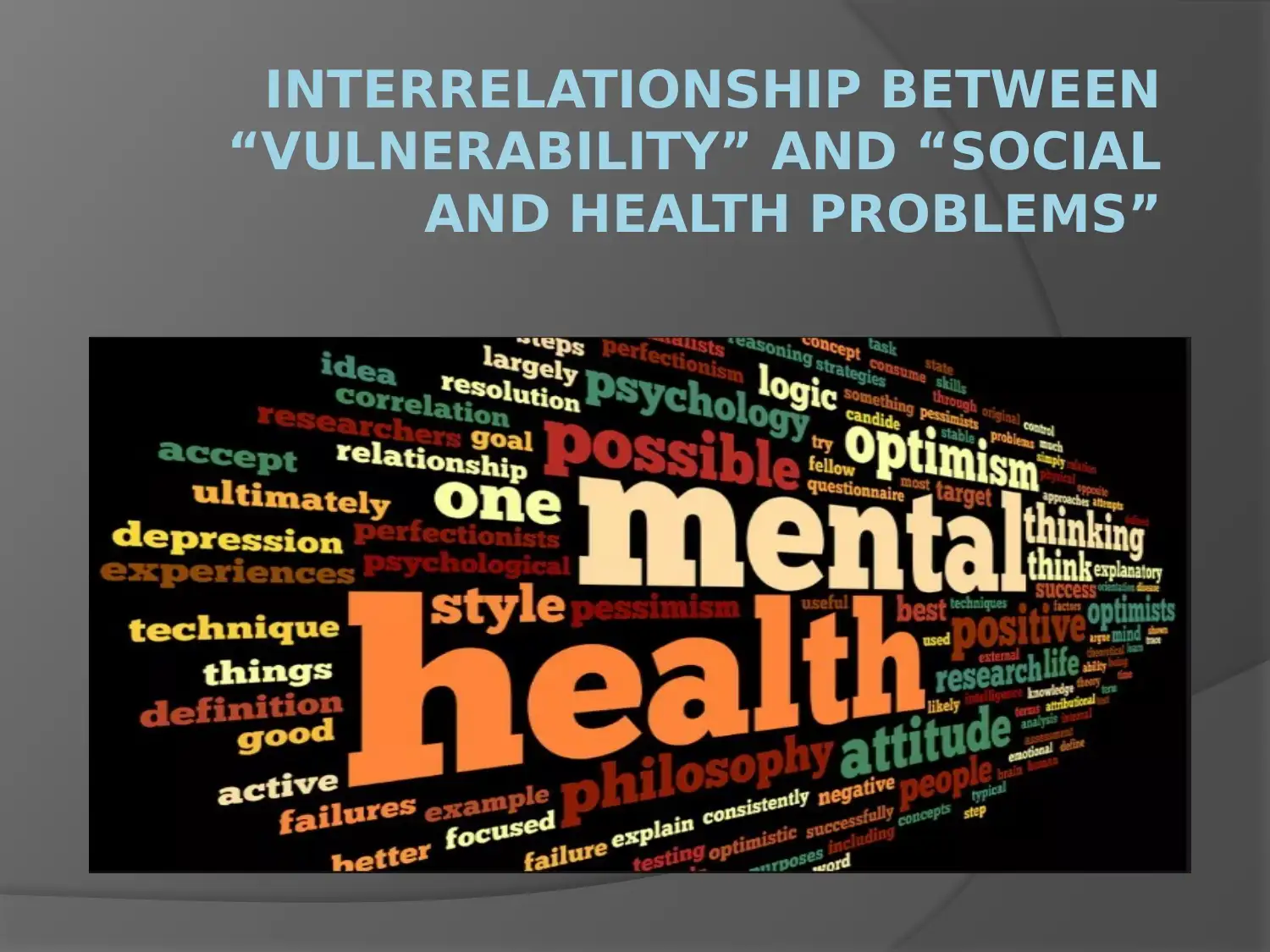
INTERRELATIONSHIP BETWEEN
“VULNERABILITY” AND “SOCIAL
AND HEALTH PROBLEMS”
“VULNERABILITY” AND “SOCIAL
AND HEALTH PROBLEMS”
Paraphrase This Document
Need a fresh take? Get an instant paraphrase of this document with our AI Paraphraser
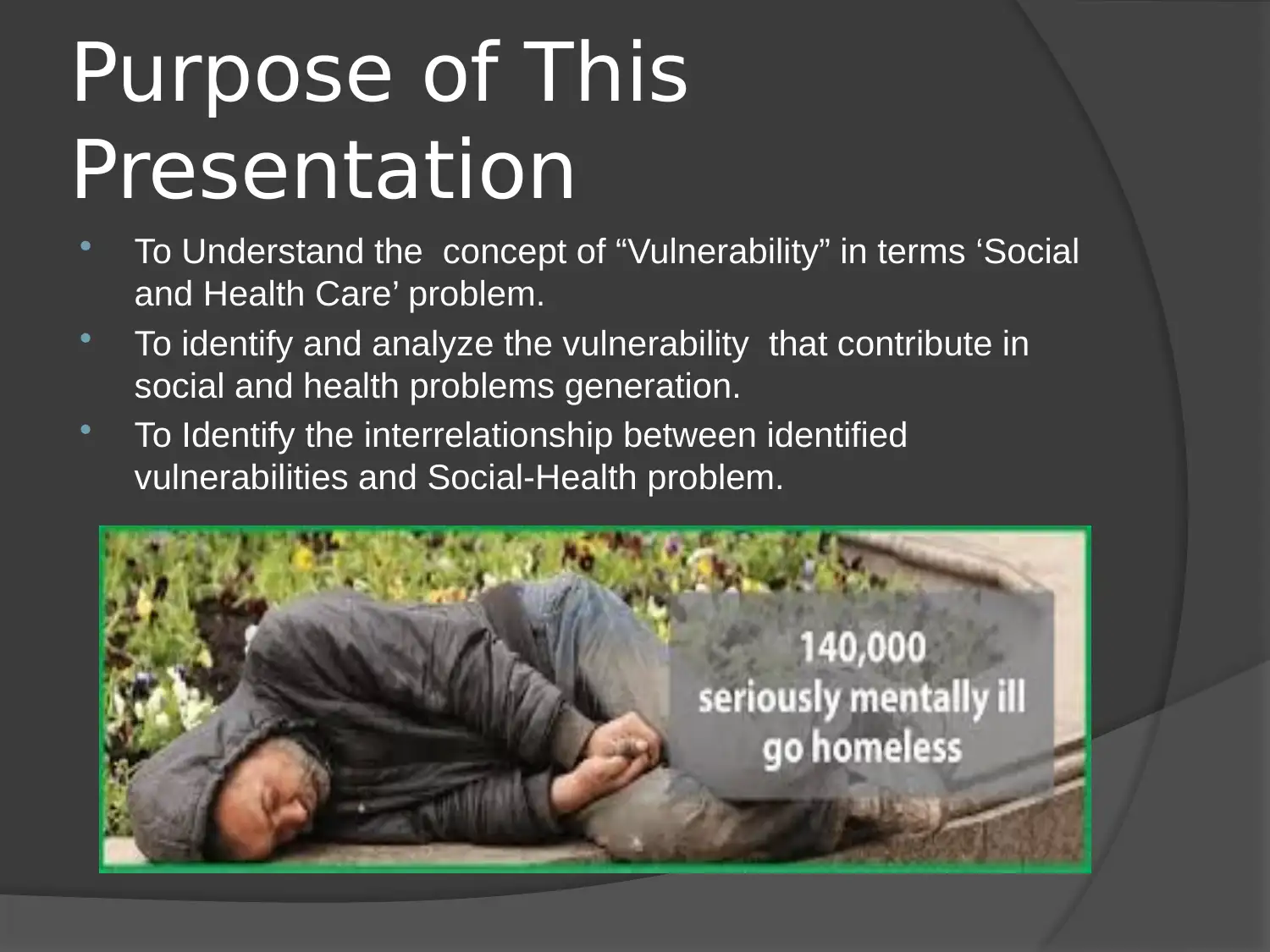
Purpose of This
Presentation
To Understand the concept of “Vulnerability” in terms ‘Social
and Health Care’ problem.
To identify and analyze the vulnerability that contribute in
social and health problems generation.
To Identify the interrelationship between identified
vulnerabilities and Social-Health problem.
Presentation
To Understand the concept of “Vulnerability” in terms ‘Social
and Health Care’ problem.
To identify and analyze the vulnerability that contribute in
social and health problems generation.
To Identify the interrelationship between identified
vulnerabilities and Social-Health problem.
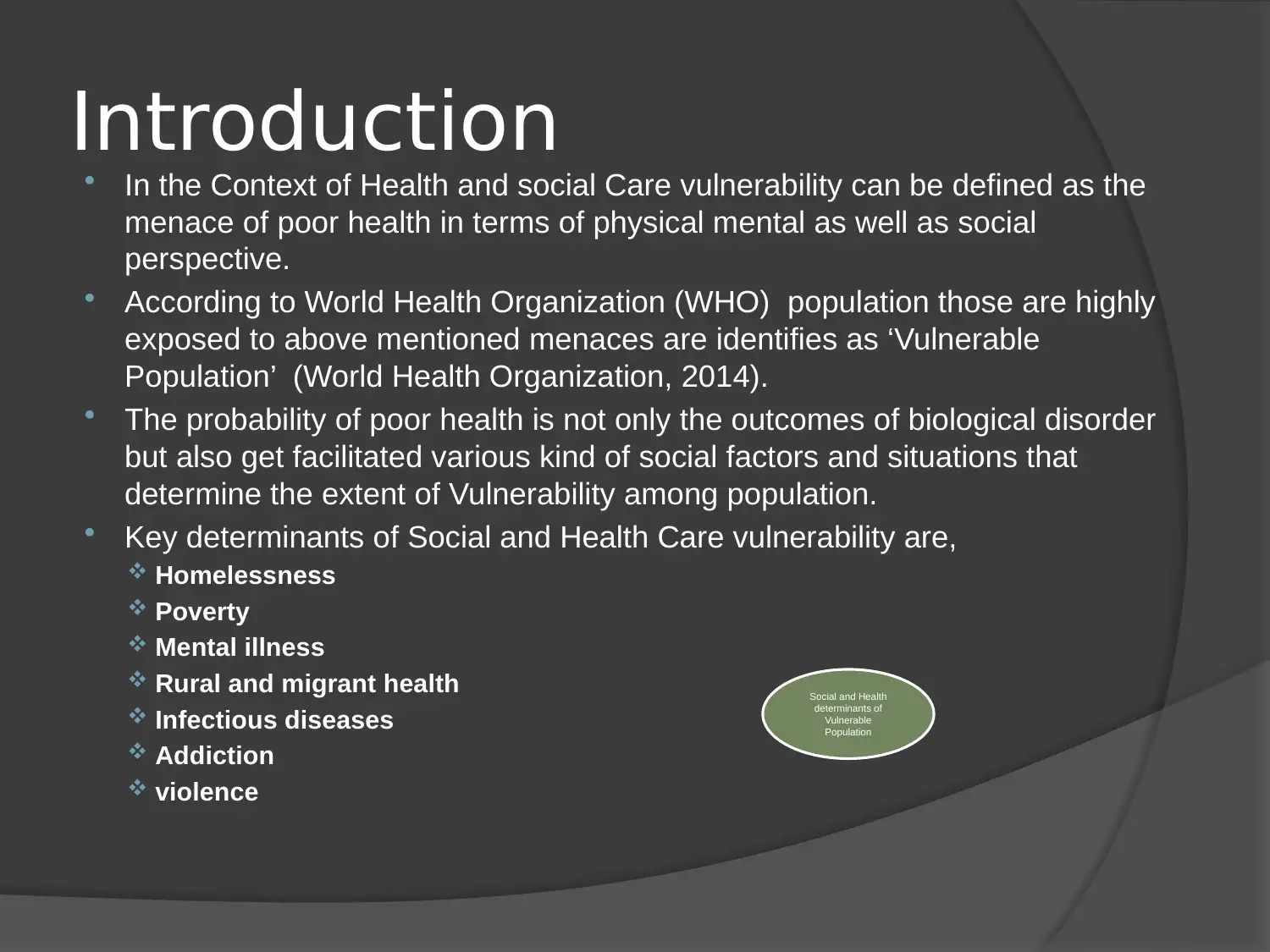
Introduction In the Context of Health and social Care vulnerability can be defined as the
menace of poor health in terms of physical mental as well as social
perspective.
According to World Health Organization (WHO) population those are highly
exposed to above mentioned menaces are identifies as ‘Vulnerable
Population’ (World Health Organization, 2014).
The probability of poor health is not only the outcomes of biological disorder
but also get facilitated various kind of social factors and situations that
determine the extent of Vulnerability among population.
Key determinants of Social and Health Care vulnerability are,
Homelessness
Poverty
Mental illness
Rural and migrant health
Infectious diseases
Addiction
violence
Social and Health
determinants of
Vulnerable
Population
menace of poor health in terms of physical mental as well as social
perspective.
According to World Health Organization (WHO) population those are highly
exposed to above mentioned menaces are identifies as ‘Vulnerable
Population’ (World Health Organization, 2014).
The probability of poor health is not only the outcomes of biological disorder
but also get facilitated various kind of social factors and situations that
determine the extent of Vulnerability among population.
Key determinants of Social and Health Care vulnerability are,
Homelessness
Poverty
Mental illness
Rural and migrant health
Infectious diseases
Addiction
violence
Social and Health
determinants of
Vulnerable
Population
⊘ This is a preview!⊘
Do you want full access?
Subscribe today to unlock all pages.

Trusted by 1+ million students worldwide
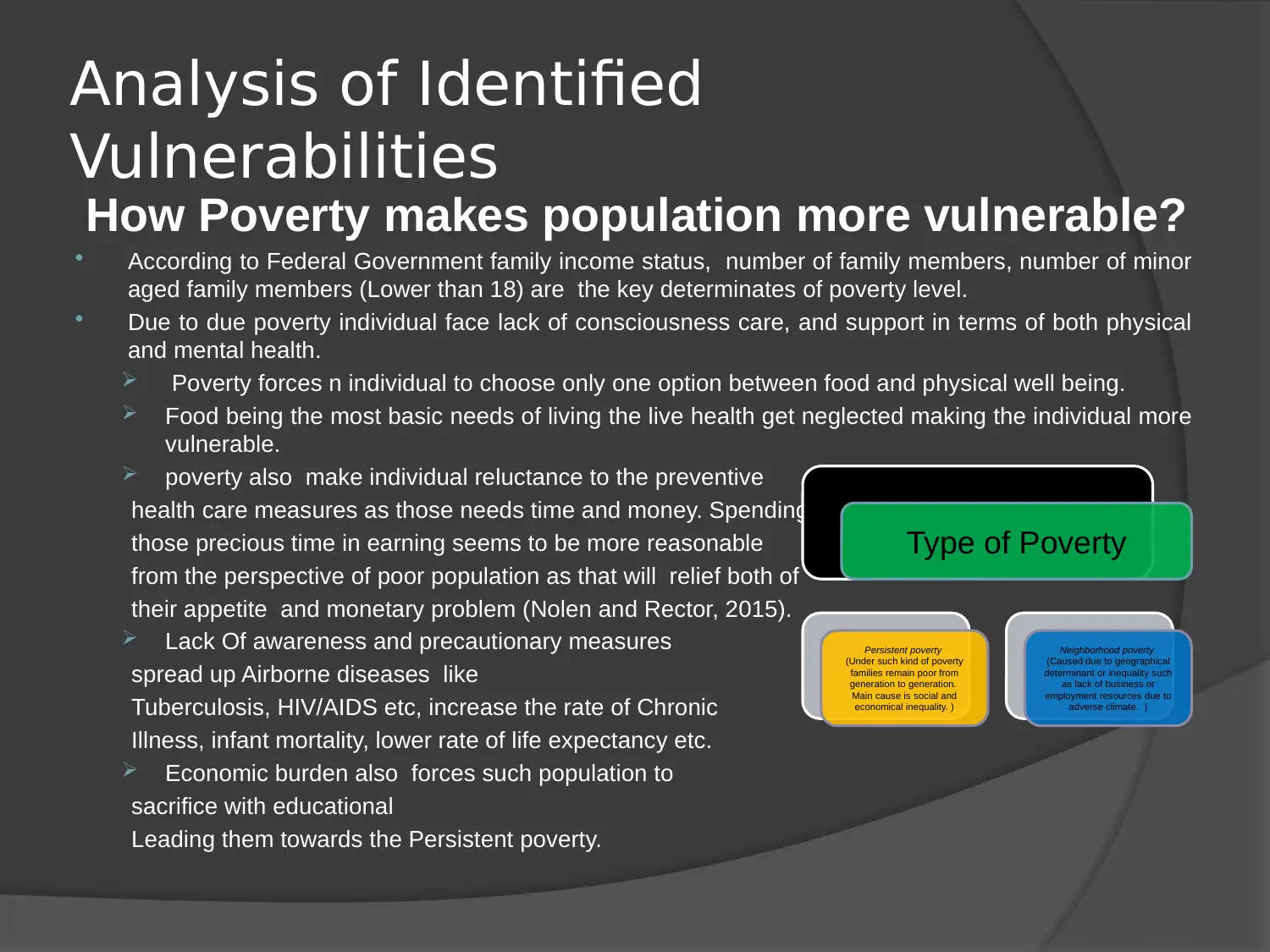
Analysis of Identified
Vulnerabilities
How Poverty makes population more vulnerable?
According to Federal Government family income status, number of family members, number of minor
aged family members (Lower than 18) are the key determinates of poverty level.
Due to due poverty individual face lack of consciousness care, and support in terms of both physical
and mental health.
Poverty forces n individual to choose only one option between food and physical well being.
Food being the most basic needs of living the live health get neglected making the individual more
vulnerable.
poverty also make individual reluctance to the preventive
health care measures as those needs time and money. Spending
those precious time in earning seems to be more reasonable
from the perspective of poor population as that will relief both of
their appetite and monetary problem (Nolen and Rector, 2015).
Lack Of awareness and precautionary measures
spread up Airborne diseases like
Tuberculosis, HIV/AIDS etc, increase the rate of Chronic
Illness, infant mortality, lower rate of life expectancy etc.
Economic burden also forces such population to
sacrifice with educational
Leading them towards the Persistent poverty.
Type of Poverty
Persistent poverty
(Under such kind of poverty
families remain poor from
generation to generation.
Main cause is social and
economical inequality. )
Neighborhood poverty
(Caused due to geographical
determinant or inequality such
as lack of business or
employment resources due to
adverse climate. )
Vulnerabilities
How Poverty makes population more vulnerable?
According to Federal Government family income status, number of family members, number of minor
aged family members (Lower than 18) are the key determinates of poverty level.
Due to due poverty individual face lack of consciousness care, and support in terms of both physical
and mental health.
Poverty forces n individual to choose only one option between food and physical well being.
Food being the most basic needs of living the live health get neglected making the individual more
vulnerable.
poverty also make individual reluctance to the preventive
health care measures as those needs time and money. Spending
those precious time in earning seems to be more reasonable
from the perspective of poor population as that will relief both of
their appetite and monetary problem (Nolen and Rector, 2015).
Lack Of awareness and precautionary measures
spread up Airborne diseases like
Tuberculosis, HIV/AIDS etc, increase the rate of Chronic
Illness, infant mortality, lower rate of life expectancy etc.
Economic burden also forces such population to
sacrifice with educational
Leading them towards the Persistent poverty.
Type of Poverty
Persistent poverty
(Under such kind of poverty
families remain poor from
generation to generation.
Main cause is social and
economical inequality. )
Neighborhood poverty
(Caused due to geographical
determinant or inequality such
as lack of business or
employment resources due to
adverse climate. )
Paraphrase This Document
Need a fresh take? Get an instant paraphrase of this document with our AI Paraphraser
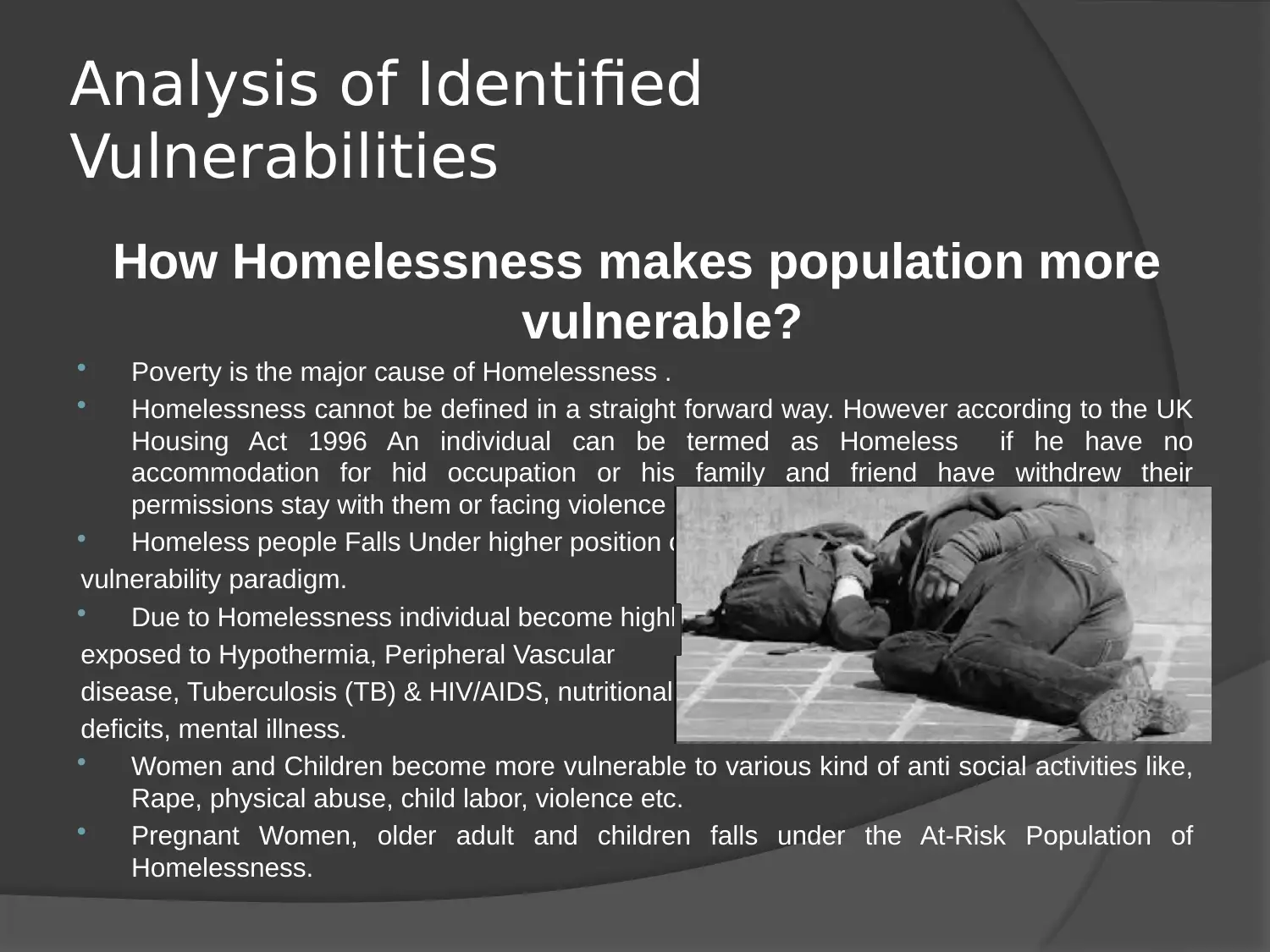
Analysis of Identified
Vulnerabilities
How Homelessness makes population more
vulnerable?
Poverty is the major cause of Homelessness .
Homelessness cannot be defined in a straight forward way. However according to the UK
Housing Act 1996 An individual can be termed as Homeless if he have no
accommodation for hid occupation or his family and friend have withdrew their
permissions stay with them or facing violence or abuse at his shelters.
Homeless people Falls Under higher position of
vulnerability paradigm.
Due to Homelessness individual become highly
exposed to Hypothermia, Peripheral Vascular
disease, Tuberculosis (TB) & HIV/AIDS, nutritional
deficits, mental illness.
Women and Children become more vulnerable to various kind of anti social activities like,
Rape, physical abuse, child labor, violence etc.
Pregnant Women, older adult and children falls under the At-Risk Population of
Homelessness.
Vulnerabilities
How Homelessness makes population more
vulnerable?
Poverty is the major cause of Homelessness .
Homelessness cannot be defined in a straight forward way. However according to the UK
Housing Act 1996 An individual can be termed as Homeless if he have no
accommodation for hid occupation or his family and friend have withdrew their
permissions stay with them or facing violence or abuse at his shelters.
Homeless people Falls Under higher position of
vulnerability paradigm.
Due to Homelessness individual become highly
exposed to Hypothermia, Peripheral Vascular
disease, Tuberculosis (TB) & HIV/AIDS, nutritional
deficits, mental illness.
Women and Children become more vulnerable to various kind of anti social activities like,
Rape, physical abuse, child labor, violence etc.
Pregnant Women, older adult and children falls under the At-Risk Population of
Homelessness.
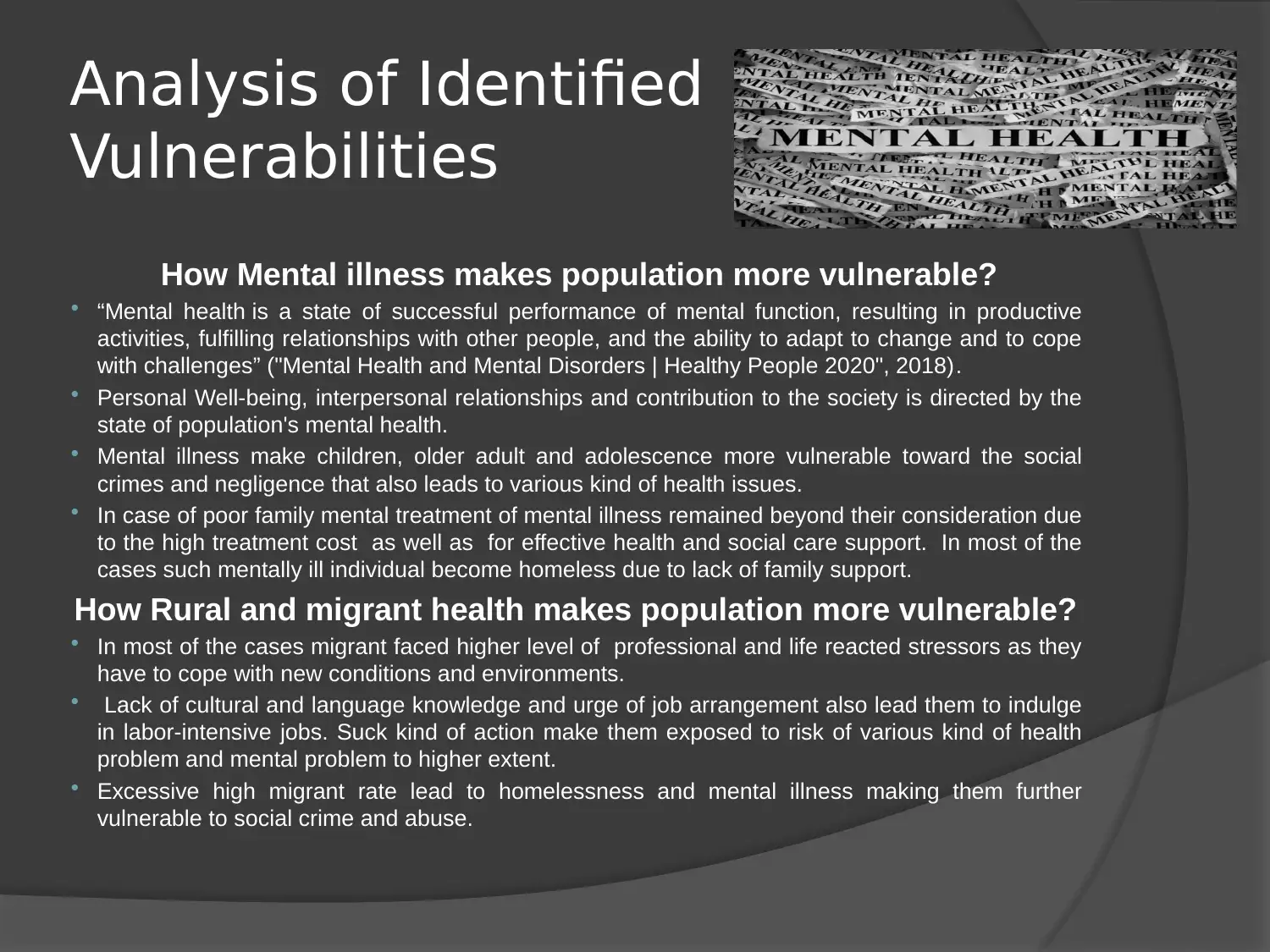
Analysis of Identified
Vulnerabilities
How Mental illness makes population more vulnerable?
“Mental health is a state of successful performance of mental function, resulting in productive
activities, fulfilling relationships with other people, and the ability to adapt to change and to cope
with challenges” ("Mental Health and Mental Disorders | Healthy People 2020", 2018).
Personal Well-being, interpersonal relationships and contribution to the society is directed by the
state of population's mental health.
Mental illness make children, older adult and adolescence more vulnerable toward the social
crimes and negligence that also leads to various kind of health issues.
In case of poor family mental treatment of mental illness remained beyond their consideration due
to the high treatment cost as well as for effective health and social care support. In most of the
cases such mentally ill individual become homeless due to lack of family support.
How Rural and migrant health makes population more vulnerable?
In most of the cases migrant faced higher level of professional and life reacted stressors as they
have to cope with new conditions and environments.
Lack of cultural and language knowledge and urge of job arrangement also lead them to indulge
in labor-intensive jobs. Suck kind of action make them exposed to risk of various kind of health
problem and mental problem to higher extent.
Excessive high migrant rate lead to homelessness and mental illness making them further
vulnerable to social crime and abuse.
Vulnerabilities
How Mental illness makes population more vulnerable?
“Mental health is a state of successful performance of mental function, resulting in productive
activities, fulfilling relationships with other people, and the ability to adapt to change and to cope
with challenges” ("Mental Health and Mental Disorders | Healthy People 2020", 2018).
Personal Well-being, interpersonal relationships and contribution to the society is directed by the
state of population's mental health.
Mental illness make children, older adult and adolescence more vulnerable toward the social
crimes and negligence that also leads to various kind of health issues.
In case of poor family mental treatment of mental illness remained beyond their consideration due
to the high treatment cost as well as for effective health and social care support. In most of the
cases such mentally ill individual become homeless due to lack of family support.
How Rural and migrant health makes population more vulnerable?
In most of the cases migrant faced higher level of professional and life reacted stressors as they
have to cope with new conditions and environments.
Lack of cultural and language knowledge and urge of job arrangement also lead them to indulge
in labor-intensive jobs. Suck kind of action make them exposed to risk of various kind of health
problem and mental problem to higher extent.
Excessive high migrant rate lead to homelessness and mental illness making them further
vulnerable to social crime and abuse.
⊘ This is a preview!⊘
Do you want full access?
Subscribe today to unlock all pages.

Trusted by 1+ million students worldwide
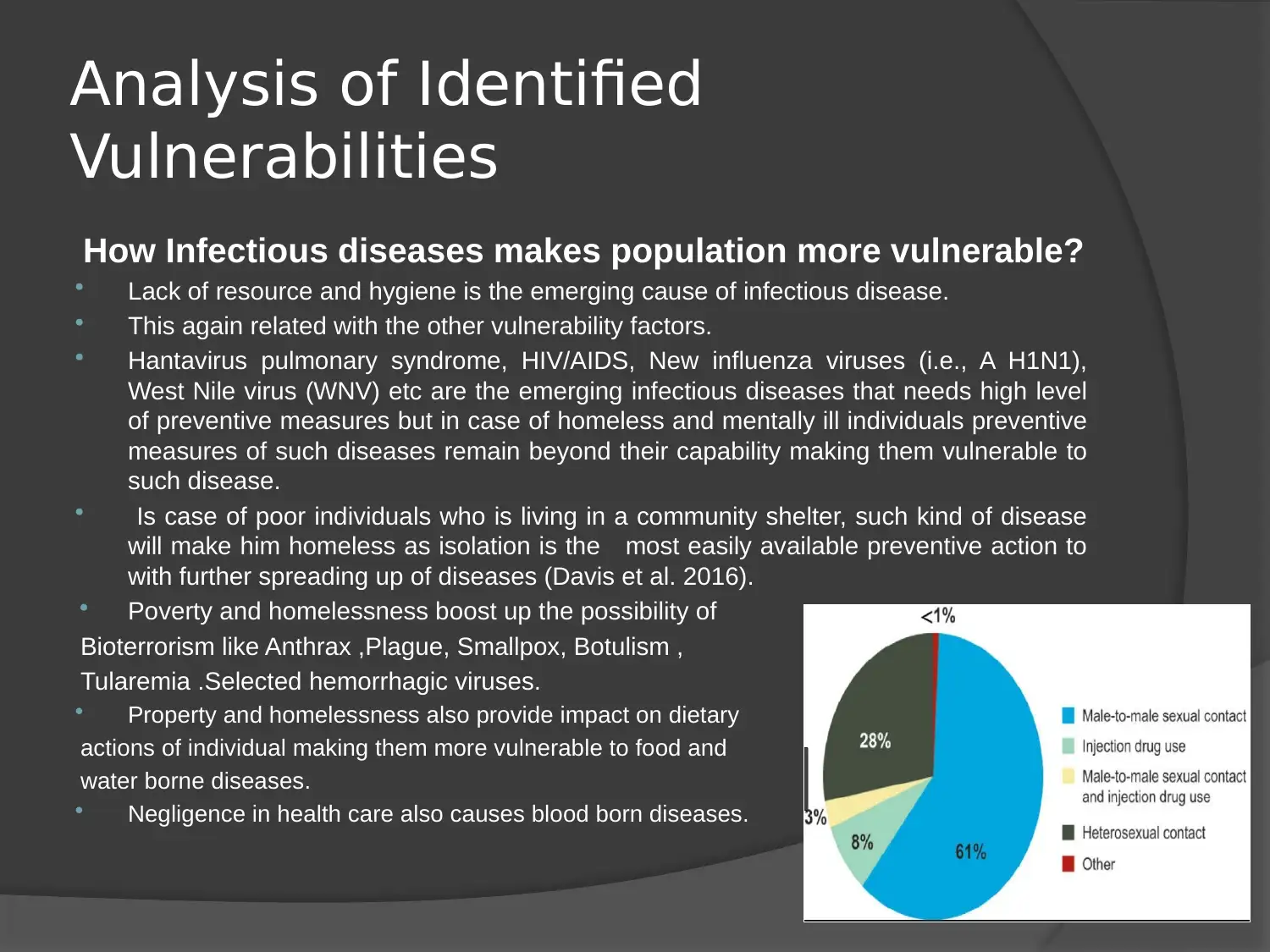
Analysis of Identified
Vulnerabilities
How Infectious diseases makes population more vulnerable?
Lack of resource and hygiene is the emerging cause of infectious disease.
This again related with the other vulnerability factors.
Hantavirus pulmonary syndrome, HIV/AIDS, New influenza viruses (i.e., A H1N1),
West Nile virus (WNV) etc are the emerging infectious diseases that needs high level
of preventive measures but in case of homeless and mentally ill individuals preventive
measures of such diseases remain beyond their capability making them vulnerable to
such disease.
Is case of poor individuals who is living in a community shelter, such kind of disease
will make him homeless as isolation is the most easily available preventive action to
with further spreading up of diseases (Davis et al. 2016).
Poverty and homelessness boost up the possibility of
Bioterrorism like Anthrax ,Plague, Smallpox, Botulism ,
Tularemia .Selected hemorrhagic viruses.
Property and homelessness also provide impact on dietary
actions of individual making them more vulnerable to food and
water borne diseases.
Negligence in health care also causes blood born diseases.
Vulnerabilities
How Infectious diseases makes population more vulnerable?
Lack of resource and hygiene is the emerging cause of infectious disease.
This again related with the other vulnerability factors.
Hantavirus pulmonary syndrome, HIV/AIDS, New influenza viruses (i.e., A H1N1),
West Nile virus (WNV) etc are the emerging infectious diseases that needs high level
of preventive measures but in case of homeless and mentally ill individuals preventive
measures of such diseases remain beyond their capability making them vulnerable to
such disease.
Is case of poor individuals who is living in a community shelter, such kind of disease
will make him homeless as isolation is the most easily available preventive action to
with further spreading up of diseases (Davis et al. 2016).
Poverty and homelessness boost up the possibility of
Bioterrorism like Anthrax ,Plague, Smallpox, Botulism ,
Tularemia .Selected hemorrhagic viruses.
Property and homelessness also provide impact on dietary
actions of individual making them more vulnerable to food and
water borne diseases.
Negligence in health care also causes blood born diseases.
Paraphrase This Document
Need a fresh take? Get an instant paraphrase of this document with our AI Paraphraser
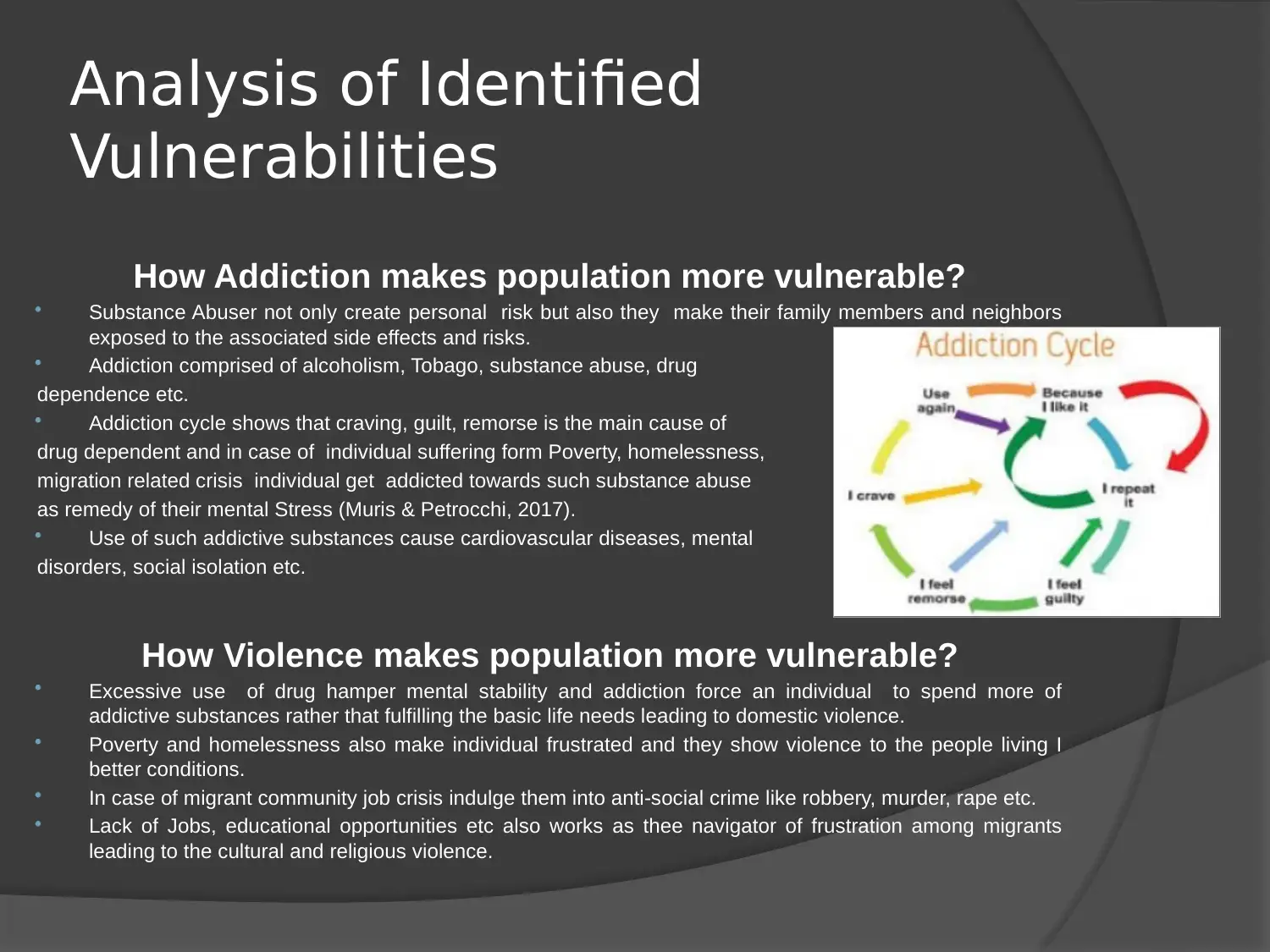
Analysis of Identified
Vulnerabilities
How Addiction makes population more vulnerable?
Substance Abuser not only create personal risk but also they make their family members and neighbors
exposed to the associated side effects and risks.
Addiction comprised of alcoholism, Tobago, substance abuse, drug
dependence etc.
Addiction cycle shows that craving, guilt, remorse is the main cause of
drug dependent and in case of individual suffering form Poverty, homelessness,
migration related crisis individual get addicted towards such substance abuse
as remedy of their mental Stress (Muris & Petrocchi, 2017).
Use of such addictive substances cause cardiovascular diseases, mental
disorders, social isolation etc.
How Violence makes population more vulnerable?
Excessive use of drug hamper mental stability and addiction force an individual to spend more of
addictive substances rather that fulfilling the basic life needs leading to domestic violence.
Poverty and homelessness also make individual frustrated and they show violence to the people living I
better conditions.
In case of migrant community job crisis indulge them into anti-social crime like robbery, murder, rape etc.
Lack of Jobs, educational opportunities etc also works as thee navigator of frustration among migrants
leading to the cultural and religious violence.
Vulnerabilities
How Addiction makes population more vulnerable?
Substance Abuser not only create personal risk but also they make their family members and neighbors
exposed to the associated side effects and risks.
Addiction comprised of alcoholism, Tobago, substance abuse, drug
dependence etc.
Addiction cycle shows that craving, guilt, remorse is the main cause of
drug dependent and in case of individual suffering form Poverty, homelessness,
migration related crisis individual get addicted towards such substance abuse
as remedy of their mental Stress (Muris & Petrocchi, 2017).
Use of such addictive substances cause cardiovascular diseases, mental
disorders, social isolation etc.
How Violence makes population more vulnerable?
Excessive use of drug hamper mental stability and addiction force an individual to spend more of
addictive substances rather that fulfilling the basic life needs leading to domestic violence.
Poverty and homelessness also make individual frustrated and they show violence to the people living I
better conditions.
In case of migrant community job crisis indulge them into anti-social crime like robbery, murder, rape etc.
Lack of Jobs, educational opportunities etc also works as thee navigator of frustration among migrants
leading to the cultural and religious violence.
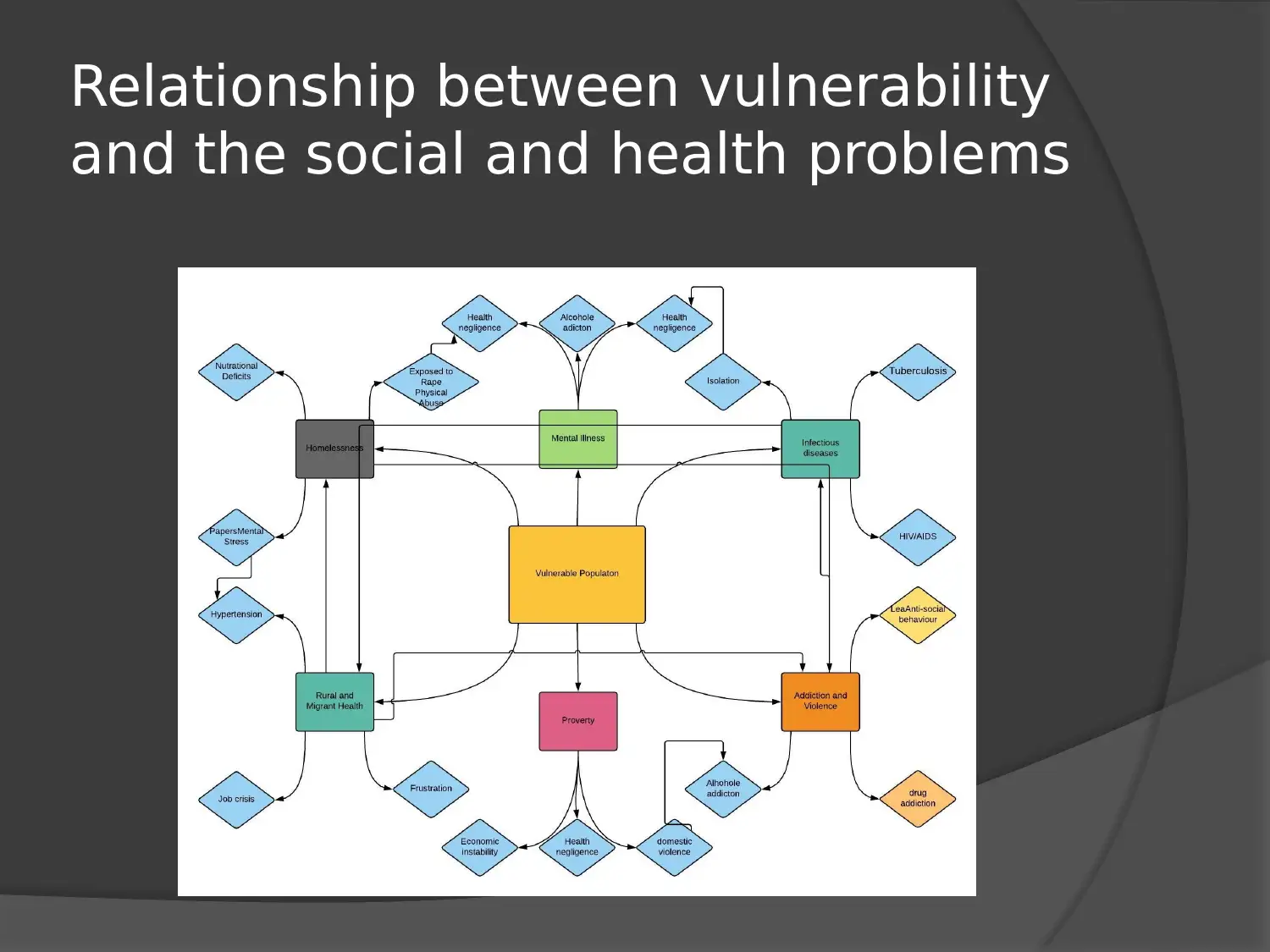
Relationship between vulnerability
and the social and health problems
and the social and health problems
⊘ This is a preview!⊘
Do you want full access?
Subscribe today to unlock all pages.

Trusted by 1+ million students worldwide
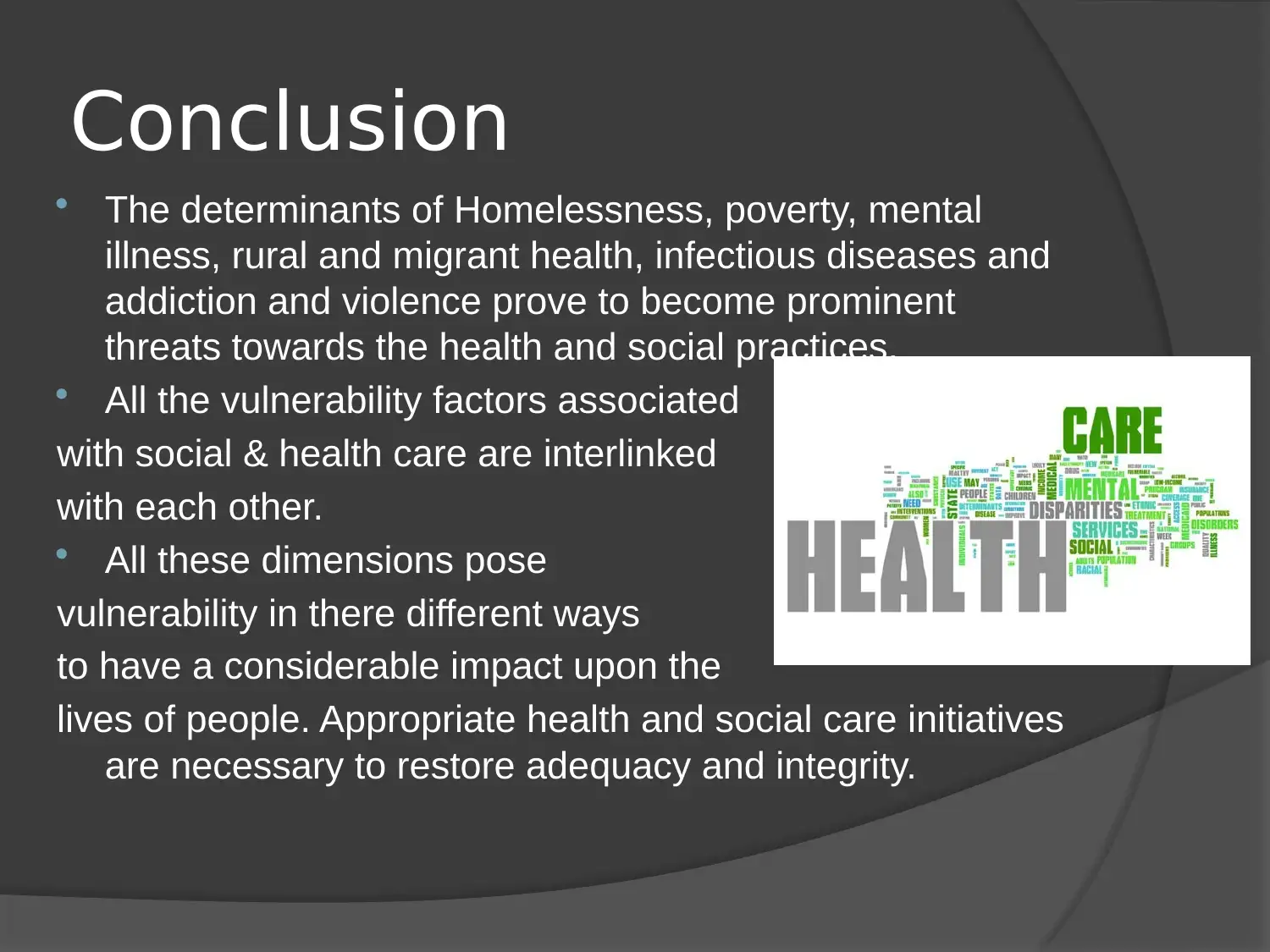
Conclusion
The determinants of Homelessness, poverty, mental
illness, rural and migrant health, infectious diseases and
addiction and violence prove to become prominent
threats towards the health and social practices.
All the vulnerability factors associated
with social & health care are interlinked
with each other.
All these dimensions pose
vulnerability in there different ways
to have a considerable impact upon the
lives of people. Appropriate health and social care initiatives
are necessary to restore adequacy and integrity.
The determinants of Homelessness, poverty, mental
illness, rural and migrant health, infectious diseases and
addiction and violence prove to become prominent
threats towards the health and social practices.
All the vulnerability factors associated
with social & health care are interlinked
with each other.
All these dimensions pose
vulnerability in there different ways
to have a considerable impact upon the
lives of people. Appropriate health and social care initiatives
are necessary to restore adequacy and integrity.
Paraphrase This Document
Need a fresh take? Get an instant paraphrase of this document with our AI Paraphraser
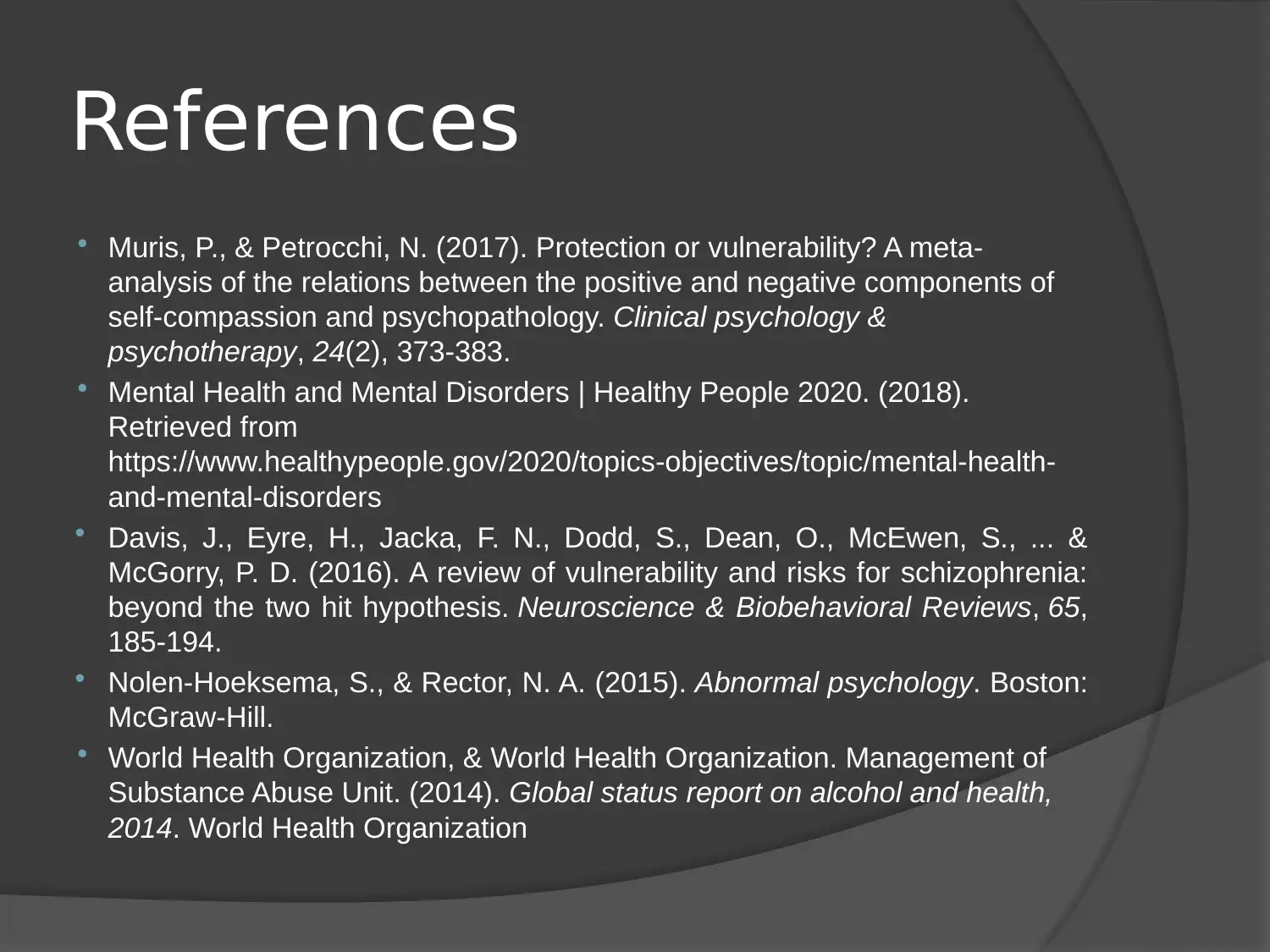
References
Muris, P., & Petrocchi, N. (2017). Protection or vulnerability? A meta‐
analysis of the relations between the positive and negative components of
self‐compassion and psychopathology. Clinical psychology &
psychotherapy, 24(2), 373-383.
Mental Health and Mental Disorders | Healthy People 2020. (2018).
Retrieved from
https://www.healthypeople.gov/2020/topics-objectives/topic/mental-health-
and-mental-disorders
Davis, J., Eyre, H., Jacka, F. N., Dodd, S., Dean, O., McEwen, S., ... &
McGorry, P. D. (2016). A review of vulnerability and risks for schizophrenia:
beyond the two hit hypothesis. Neuroscience & Biobehavioral Reviews, 65,
185-194.
Nolen-Hoeksema, S., & Rector, N. A. (2015). Abnormal psychology. Boston:
McGraw-Hill.
World Health Organization, & World Health Organization. Management of
Substance Abuse Unit. (2014). Global status report on alcohol and health,
2014. World Health Organization
Muris, P., & Petrocchi, N. (2017). Protection or vulnerability? A meta‐
analysis of the relations between the positive and negative components of
self‐compassion and psychopathology. Clinical psychology &
psychotherapy, 24(2), 373-383.
Mental Health and Mental Disorders | Healthy People 2020. (2018).
Retrieved from
https://www.healthypeople.gov/2020/topics-objectives/topic/mental-health-
and-mental-disorders
Davis, J., Eyre, H., Jacka, F. N., Dodd, S., Dean, O., McEwen, S., ... &
McGorry, P. D. (2016). A review of vulnerability and risks for schizophrenia:
beyond the two hit hypothesis. Neuroscience & Biobehavioral Reviews, 65,
185-194.
Nolen-Hoeksema, S., & Rector, N. A. (2015). Abnormal psychology. Boston:
McGraw-Hill.
World Health Organization, & World Health Organization. Management of
Substance Abuse Unit. (2014). Global status report on alcohol and health,
2014. World Health Organization

⊘ This is a preview!⊘
Do you want full access?
Subscribe today to unlock all pages.

Trusted by 1+ million students worldwide
1 out of 12
Related Documents
Your All-in-One AI-Powered Toolkit for Academic Success.
+13062052269
info@desklib.com
Available 24*7 on WhatsApp / Email
![[object Object]](/_next/static/media/star-bottom.7253800d.svg)
Unlock your academic potential
Copyright © 2020–2025 A2Z Services. All Rights Reserved. Developed and managed by ZUCOL.





